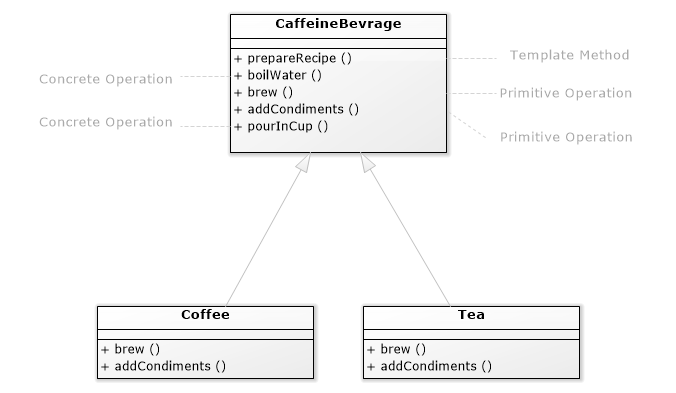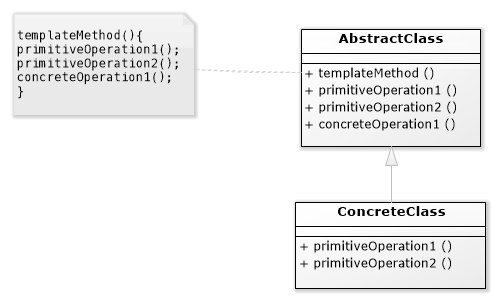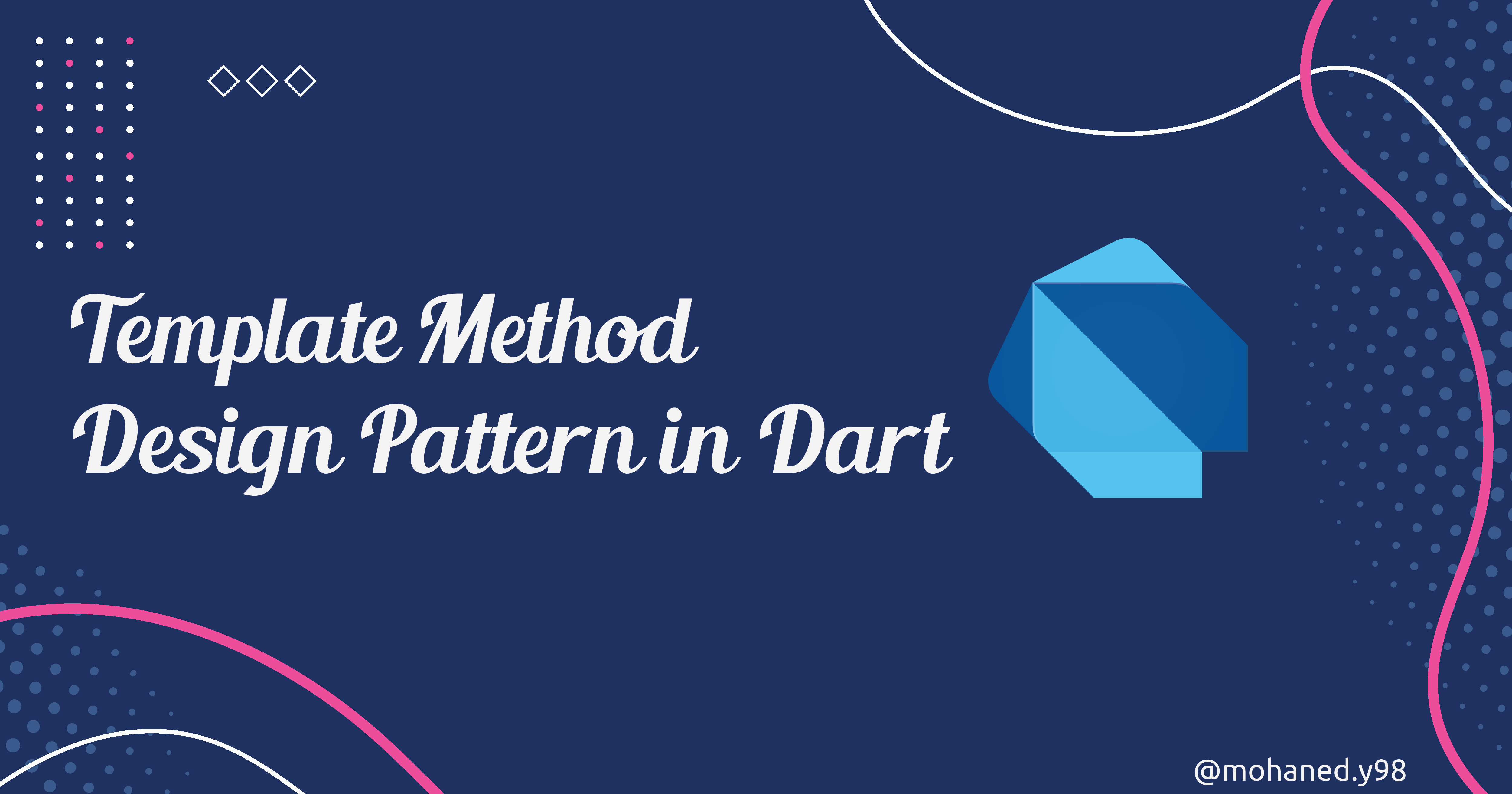Table of Contents
Definitions
The Official Definition: The Template Method Pattern defines the skeleton of an algorithm in a method, deferring some steps to subclasses. Template Method lets subclasses redefine certain steps of an algorithm without changing the algorithm’s structure.
What’s Template Method? it’s a method that defines an algorithm as a set of steps. One or more of these steps is defined to be abstract and implemented by a subclass. This ensures the algorithm’s structure stays unchanged, while subclasses provide some part of the implementation.
The Problem
To make the pattern easier to grasp let’s say we need to create a program for cafes this program will have the ability to prepare coffee and tea using the following recipes.
| Coffee Recipe | Tea Recipe |
|---|---|
| 1- Boil some water | 1- Boil some water |
| 2- Brew coffee in boiling water | 2- Steep tea in boiling water |
| 3- Pour coffee in cup | 3- Pour tea in cup |
| 4- Add sugar and milk | 4- Add lemon |
The Coffee class:
class Coffee {
void prepareRecipe() {
boilWater();
brewCoffeeGrinds();
pourInCup();
addSugarAndMilk();
}
void boilWater() {
print("Boiling water");
}
void brewCoffeeGrinds() {
print("Dripping Coffee through filter");
}
void pourInCup() {
print("Pouring into cup");
}
void addSugarAndMilk() {
print("Adding Sugar and Milk");
}
}
Each step is implemented as a separate method and all of these steps get called inside prepareRecipe() method.
The Tea class:
class Tea {
void prepareRecipe() {
boilWater();
steepTeaBag();
pourInCup();
addLemon();
}
void boilWater() {
print("Boiling water");
}
void steepTeaBag() {
print("Steeping the tea");
}
void pourInCup() {
print("Pouring into cup");
}
void addLemon() {
print("Adding Lemon");
}
}
If we compared both classes we will find out that both boilWater() and pourInCup() steps are identical in both
classes so there’s code duplication!
| Coffee | = / ≠ | Tea |
|---|---|---|
boilWater() | = | boilWater() |
brewCoffeeGrinds() | ≠ | steepTeaBag() |
pourInCup() | = | pourInCup() |
addSugarAndMilk() | ≠ | addLemon() |
To eliminate this duplication we could abstract the commonality into a base class.
let’s create a class called CaffineBeverage that wraps the duplicated code.
Also if we had a closer look we will find that both algorithms are different in two steps that are special for the kind
of the caffeine beverage we are making, so we could abstract these two steps so instead of brewCoffeeGrinds()
and steepTeaBag() steps we could make abstract step called brew(). and for the condiments we could abstract it
to addCondiments()
the new design will look like this:

CaffeineBevrage will be implemented as an abstract class
CaffeineBevrage Class
import 'package:meta/meta.dart';
abstract class CaffeineBevrage {
const CaffeineBevrage();
@nonVirtual
void prepareRecipe() {
boilWater();
brew();
pourInCup();
addCondiments();
}
void brew();
void addCondiments();
@nonVirtual
void boilWater() {
print('Boiling Water');
}
@nonVirtual
void pourInCup() {
print('Pouring into cup');
}
}
Tea Class
class Tea extends CaffeineBevrage {
@override
void addCondiments() {
print("Adding Lemon");
}
@override
void brew() {
print("Steeping the tea");
}
}
Coffee Class
class Coffee extends CaffeineBevrage {
@override
void addCondiments() {
print("Adding Sugar And Milk");
}
@override
void brew() {
print("Dripping Coffee through filter");
}
}
Now you can see that we have improved the design a lot, we have removed the duplications, Hurray!
let’s analyze the code
prepareRecipe()
is called the template method. Why?
Because It serves as a template for an algorithm, in this case, an algorithm for making caffeinated beverages.
In the template, each step of the algorithm is represented by a method.
The prepareRecipe() method controls the algorithm. No one can change this, and it counts on subclasses to provide some
or all of the implementation.
Then how we could protect this method so that subclasses wouldn’t be able to override it?
Well unfortunately unlike programming languages like java where you could use final method declaration to prevent
subclasses from overriding methods, dart doesn’t provide a keyword for preventing that instead package:meta provides
a @nonVirtual annotation to disallow overriding methods.
Note that this annotations provides hints to dartanalyzer. They won’t prevent violiating the annotations instead will cause warnings to be printed.
boilWater() & pourInCup(): are called concrete operations as they are reusable steps in both the tea and coffee
recipes so it’s implemented by the abstract class CaffeineBeverage and protected using the @nonVirtual annotation.
But why is brew() & addCondiments() are abstract?
These methods are called primitive operations because Coffee and Tea handle these methods in different ways, they’re declared as abstract, to let the subclasses worry about implementing these methods!
Template Method Pattern
This pattern is all about creating a template for an algorithm. What’s a template? As you’ve seen it’s just a method; more specifically, it’s a method that defines an algorithm as a set of steps. One or more of these steps is defined to be abstract and implemented by a subclass. This ensures the algorithm’s structure stays unchanged, while subclasses provide some part of the implementation.
The class diagram below shows the general structure of the design pattern.

-
The AbstractClass: contains the template method and abstract versions of the operations used in the template method.
-
The templateMethod makes use of the primitive & concrete operations to implement an algorithm. It is decoupled from the actual implementation of these operations.
-
The ConcreteClass implements the abstract operations, which are called when the
templateMethod()needs them, There may be many ConcreteClasses, each implementing the full set of operations required by the template method.
Let’s make some coffee & tea
void main(List<String> args) {
final cupOfTea = Tea();
cupOfTea.prepareRecipe();
print("============");
final cupOfCoffee = Coffee();
cupOfCoffee.prepareRecipe();
}
prepareRecipe() => calls the algorithm methods which some are implemented by our Tea & Coffee classes and others
are implemented already by the abstract class.
Output
Boiling Water
Steeping the tea
Pouring into cup
Adding Lemon
============
Boiling Water
Dripping Coffee through filter
Pouring into cup
Adding Sugar And Milk
Hook Method
Hook is a method that is declared in the abstract class but only given an empty or default implementation. This gives subclasses the ability to “hook into” the algorithm at various points if they wish; a subclass is also free to ignore the hook.
We could use the hook method to enhance our algorithm by making subclasses have the decision whether to
invoke addCondiments() method or not.
To do this first we will modify CaffeineBevrage abstract class by adding a concrete method that decides whether to add
condiments or not by default.
Let’s say we will make it by default always adding condiments.
abstract class CaffeineBevrageWithHook {
...
bool wantsCondiments() {
return true;
}
}
Next, we will modify our template method prepareRecipe() by adding a condition that decides whether to add condiments
or not.
abstract class CaffeineBevrageWithHook {
void prepareRecipe() {
boilWater();
brew();
pourInCup();
if (wantsCondiments()) {
addCondiments();
}
}
...
}
Now if we tested the code we will find the same output as previous, but if we want the user to decide we may override
the wantsCondiments() method in one of our subclasses Coffee / Tea and provide a different implementation
class CoffeeWithHook extends CaffeineBevrageWithHook {
....
@override
bool wantsCondiments() {
print("Do you want to add Condiments? ");
String? a = stdin.readLineSync(encoding: utf8);
if (a != null && a.toLowerCase() == 'yes') {
return true;
} else {
return false;
}
}
}
Now let’s test the code
Boiling Water
Dripping Coffee through filter
Pouring into cup
Do you want to add Condiments? No
Advantages
-
The Abstract class runs the show; as it has the algorithm, and protects it.
-
Maximizes reuse among the subclasses.
-
The algorithm lives in one place and code changes only need to be made there.
-
The Template Method Pattern provides a framework that other algorithms can be plugged into.
-
The abstract class concentrates knowledge about the algorithm and relies on subclasses to provide complete implementations.
When to use
-
When you want to avoid duplication in the code, the general workflow structure is implemented once in the abstract class’s algorithm, and necessary variations are implemented in the subclasses.
-
when you want to control at what points subclassing is allowed. As opposed to a simple polymorphic override, where the base method would be entirely rewritten allowing radical change to the workflow, only the specific details of the workflow are allowed to change.
Credits
The example used in this article is from Head First Design Patterns 2nd edition.
